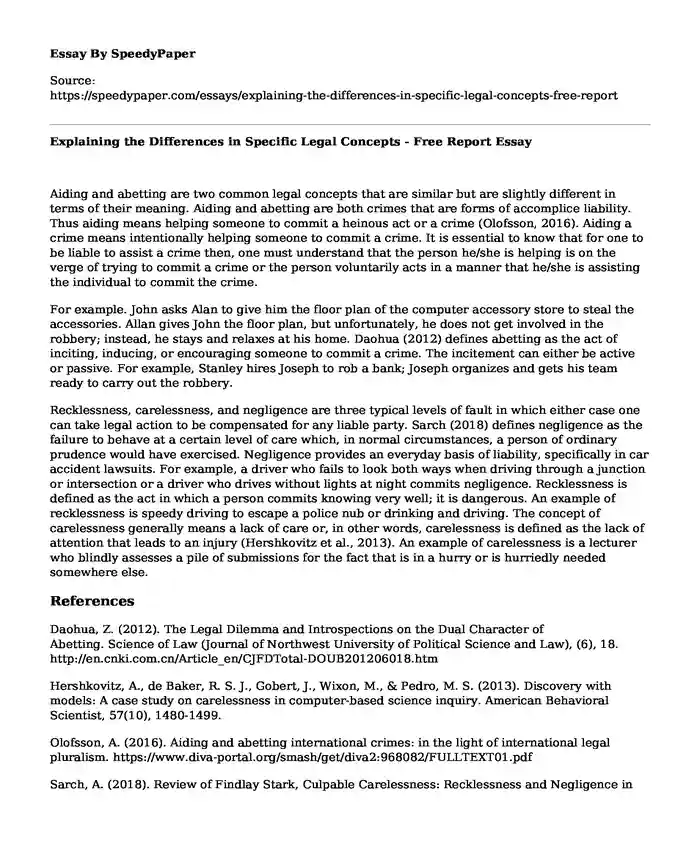Aiding and abetting are two common legal concepts that are similar but are slightly different in terms of their meaning. Aiding and abetting are both crimes that are forms of accomplice liability. Thus aiding means helping someone to commit a heinous act or a crime (Olofsson, 2016). Aiding a crime means intentionally helping someone to commit a crime. It is essential to know that for one to be liable to assist a crime then, one must understand that the person he/she is helping is on the verge of trying to commit a crime or the person voluntarily acts in a manner that he/she is assisting the individual to commit the crime.
For example. John asks Alan to give him the floor plan of the computer accessory store to steal the accessories. Allan gives John the floor plan, but unfortunately, he does not get involved in the robbery; instead, he stays and relaxes at his home. Daohua (2012) defines abetting as the act of inciting, inducing, or encouraging someone to commit a crime. The incitement can either be active or passive. For example, Stanley hires Joseph to rob a bank; Joseph organizes and gets his team ready to carry out the robbery.
Recklessness, carelessness, and negligence are three typical levels of fault in which either case one can take legal action to be compensated for any liable party. Sarch (2018) defines negligence as the failure to behave at a certain level of care which, in normal circumstances, a person of ordinary prudence would have exercised. Negligence provides an everyday basis of liability, specifically in car accident lawsuits. For example, a driver who fails to look both ways when driving through a junction or intersection or a driver who drives without lights at night commits negligence. Recklessness is defined as the act in which a person commits knowing very well; it is dangerous. An example of recklessness is speedy driving to escape a police nub or drinking and driving. The concept of carelessness generally means a lack of care or, in other words, carelessness is defined as the lack of attention that leads to an injury (Hershkovitz et al., 2013). An example of carelessness is a lecturer who blindly assesses a pile of submissions for the fact that is in a hurry or is hurriedly needed somewhere else.
References
Daohua, Z. (2012). The Legal Dilemma and Introspections on the Dual Character of Abetting. Science of Law (Journal of Northwest University of Political Science and Law), (6), 18. http://en.cnki.com.cn/Article_en/CJFDTotal-DOUB201206018.htm
Hershkovitz, A., de Baker, R. S. J., Gobert, J., Wixon, M., & Pedro, M. S. (2013). Discovery with models: A case study on carelessness in computer-based science inquiry. American Behavioral Scientist, 57(10), 1480-1499.
Olofsson, A. (2016). Aiding and abetting international crimes: in the light of international legal pluralism. https://www.diva-portal.org/smash/get/diva2:968082/FULLTEXT01.pdf
Sarch, A. (2018). Review of Findlay Stark, Culpable Carelessness: Recklessness and Negligence in the Criminal Law.
Cite this page
Explaining the Differences in Specific Legal Concepts - Free Report. (2023, Dec 26). Retrieved from https://speedypaper.net/essays/explaining-the-differences-in-specific-legal-concepts-free-report
Request Removal
If you are the original author of this essay and no longer wish to have it published on the SpeedyPaper website, please click below to request its removal:
- Free Paper for Students: Op-ed about Eliminating Cash Bail System in Philadelphia
- Free Essay. New Generation Case Resolution
- Essay Sample on Positive Behavior: Strategies for Infant and Junior Schools
- Essay Example - Business Ethical Decision Making
- Essay Example on The Role of Humor in Crisis Situation
- Designing an Intervention. Free Essay
- How Organizations Should Respond to Cyber Attacks. Essay Example
Popular categories





